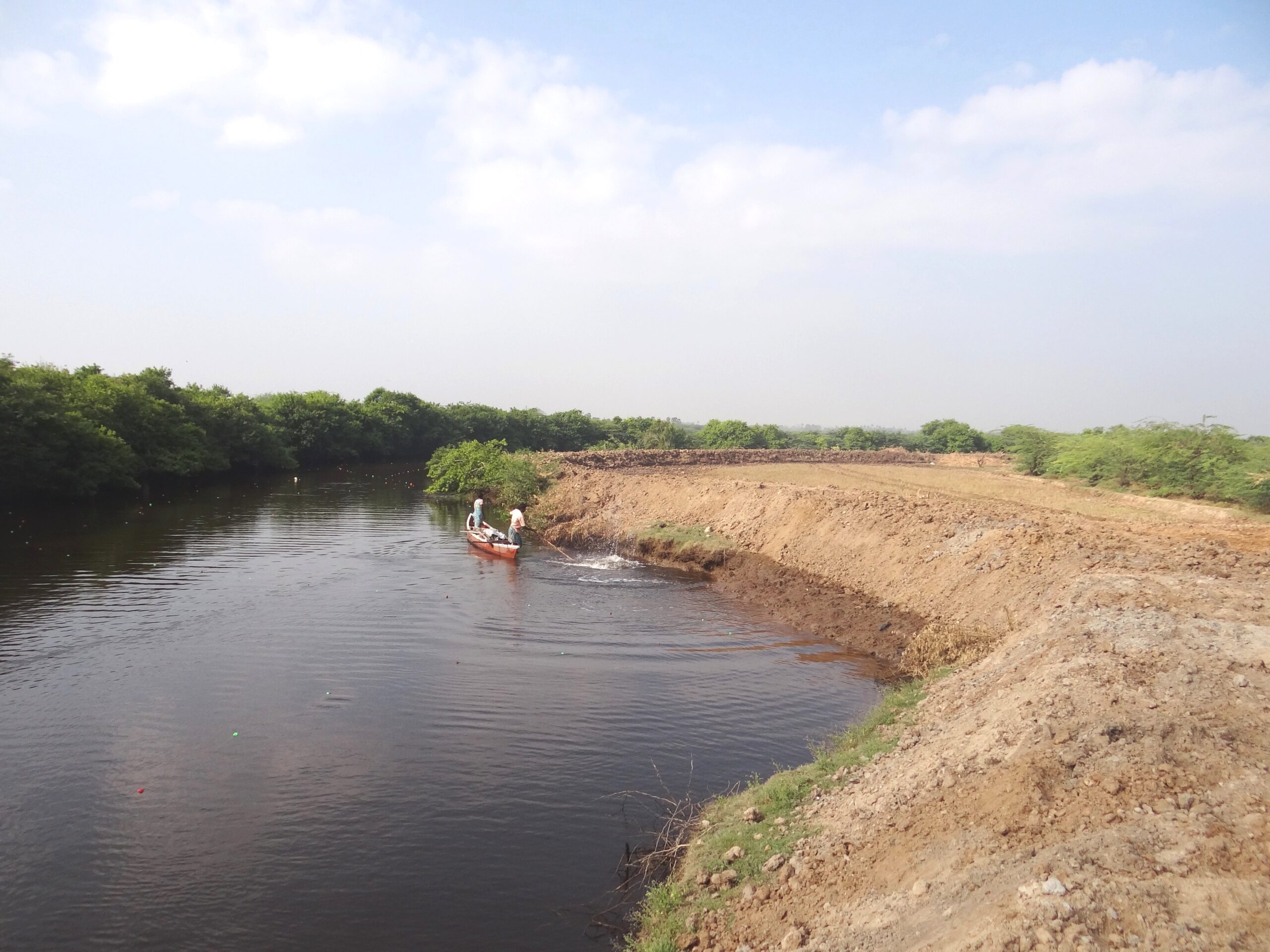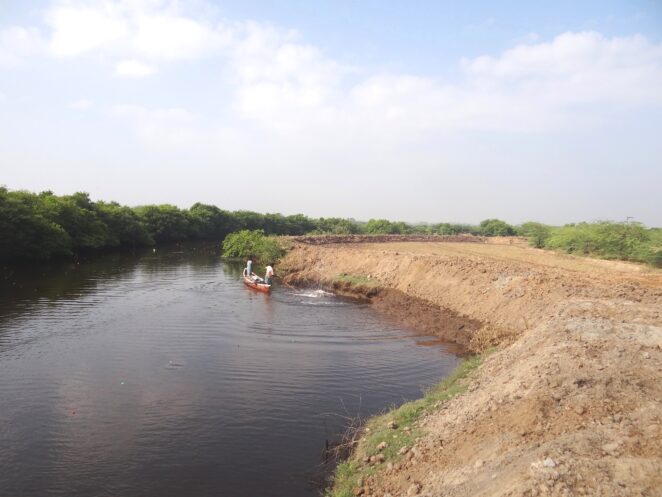Case-study /
Flood protection through a backwater river bund – Securing arable land and livelihoods in the coastal village of Nadupalayam, India


Nadupalayam’s backwater river bund protecting people and land
The village of Nadupalayam is located 2 km from the shore of the Bay of Bengal in Tamil Nadu and was strongly affected by the tsunami in 2004. In recent years the village has been increasingly hit by stronger and stronger storms. During extreme weather events sea water floods the fields. Salty water has also been infiltrating into the groundwater along the coastline. The storm floods damaged the agricultural land heavily and have made the soil too saline to yield crops. Nearly 180 acres of land had turned saline due to backwater flooding in from the inlet. The existing irrigation channels were put under pressure as well. The central channel – a vital freshwater source for irrigation – was particularly affected by infiltrating salt water. With most of the villagers sustaining their living from the agricultural sector, 20-30 % of the people were forced to migrate or commute as employment opportunities became scarce in the area.
To address the salt water intrusion, the community – supported by the EU-sponsored project “AdaptCap” – raised, widened and extended the village’s backwater river bund. To achieve a high stability the bund was strengthened with clay and soil. It now runs between the backwaters and agricultural fields over a distance of 1.5 km and protects the fields from becoming saline. In addition, 636 families in Nadupalayam and in 13 other villages in the area now also have access to saline-free fresh water canals and groundwater. The backwater river bund has helped gain new land for cultivation. The Village Development Committee state that this adaptation measure has encouraged farmers to continue in the agricultural sector and not leave it for other employment opportunities. The key benefits of this adaptation measure are:
- Increase of agricultural command area: 370 acres are protected from salt water intrusion, making more cultivation possible.
- Increase in harvest: Currently 7.6 tons are harvested (in comparison to 2.7 tons harvested on the saline land) and an increase is expected due to the crop rotation scheme that is to be followed in forthcoming years.
Implementation cost
The overall costs of this adaptation measure – including a local vulnerability and needs assessment, capacity building measures in the community, technical support as well as material and labour costs – amounted to Rs. 407,880. Of these, Rs. 382,880 were borne by AdaptCap while the community contributed Rs. 25,000.
Operation & maintenance of the system
In order to remain operative in the long run, several parts of the system require regular operation and maintenance (O&M). Regular O&M activities include:
- Verifying the constructed bund is intact and working
- Reinforcing and repairing the bund on a regular basis
- Maintaining the bund grass cover
The community has distributed the responsibilities and timeframes for O&M activities among their members. Practically all maintenance activities are implemented by the community itself, strongly supported by the local farmer’s club and the Village Development Committee (VDC) of Nadupalayam. The average monthly O&M costs amount to Rs. 2,500. The community collects a monthly contribution fee from all the beneficiaries in the village.
M&E of activities and benefits
A monitoring and evaluation (M&E) system was developed to regularly screen and assess the adaptation project’s sustainability and impact. Information is collected in four areas:
- Effectively achieved vulnerability reduction
- Acceptance by and technical feasibility for the community
- Cost for implementation and regular O&M
- Positive and negative side effects (i.e., environmental, social, economic)
Challenges and lessons learnt
- Building such a bund should not be done during the rainy season as heavy rain events can damage the bund while under construction and delay the drying and finishing. A time schedule needs to be designed keeping this in mind.
- Necessary changes or ideas on improvements, which should be considered when replicating such an adaptation project, should be documented during implementation.
- Obtain all relevant permissions from the respective departments before implementing the adaptation measure.
- Large amounts of soil and mud are necessary and their availability needs to be ensured before the construction work starts.
Project background and partners
The project “AdaptCap – Strengthening Adaptation Capacities and Minimizing Risks of Vulnerable Coastal Communities in India” financed by the European Commission has set out to strengthen the adaptation capacities of vulnerable coastal communities in Andhra Pradesh and Tamil Nadu (India) and minimize their climate change-related risks using an integrated approach.
The three-year initiative is implemented by the Indo-German Environment Partnership Programme of Deutsche Gesellschaft für Internationale Zusammenarbeit (GIZ-IGEP) in partnership with four Indian and international partners.
GIZ-IGEP is responsible for the overall implementation and project management.
AVVAI Village Welfare Society (AVVAI)supports the stakeholders in three cities and nine villages in Tamil Nadu as a local partner, providing training and implementation support in assessing adaptation needs and developing and carrying out adaptation measures.
Academy of Gandhian Studies (AGS) fulfills the same role in Andhra Pradesh.
adelphicontributed to developing technology solutions for the pilot projects and M&E frameworks, designing and implementing capacity building programmes and providing technical support for pilot project implementation.
ICLEI South Asia led the implementation of activities in the six urban areas targeted by AdaptCap.
